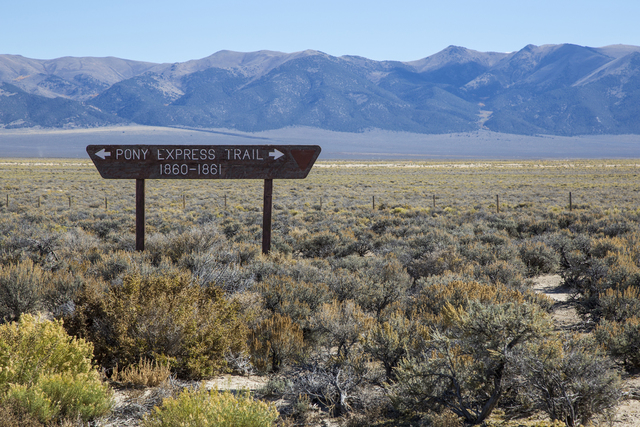Horses, riders to take on Nevada’s Pony Express route

Horses and riders will thunder across more than 400 miles of Nevada this week during the annual 10-day re-ride of the Pony Express route of 1860-61.
Sponsored by the National Pony Express Association, 600 riders and horses gallop across seven states on the 1,966-mile trail. Traveling in relays night and day, the riders started Monday in St. Joseph, Mo., and will finish Thursday in Sacramento, Calif.
The old trail roughly parallels U.S. Highway 50 from the Utah border to the California-Nevada border at Lake Tahoe, a portion of Nevada now known as “Pony Express Territory.” Although much of the 155-year-old trail runs through backcountry, there a few easily accessible viewpoints along U.S. Highway 93, U.S. Highway 95 and U.S. 50.
The first stop in Nevada heading west is near old Fort Shelbourne on U.S. 93 northeast of Ely. Riders are near U.S. 50 at sites of original Pony Express stations at Cold Springs, Sand Springs and Fort Churchill’s Buckland Station. They cross U.S. 95 near Schurz. They will be visible near Austin’s cemetery, Fallon, Dayton, Carson City and Genoa. The last Nevada rider passes the mail to the first California rider at Lake Tahoe on U.S. 50 just south of Harrah’s. The event concludes at Old Sacramento the next day.
Travelers exploring Nevada’s heartland along U.S. 50 need just a little imagination to find legends coming to life, even if they miss seeing the relay riders. The highway runs through varied landscapes little changed since frontier times. It is not hard to imagine seeing the dust of those racing ponies across broad sage flats and dry lakes. Listen for the ring of shod hooves on stony trails through rugged canyons or over mountain passes.
Once labeled “the loneliest road in America” by a national publication, U.S. 50 reveals the Silver State’s heartland far from our glittering urban centers. The highway links a string of picturesque mining towns, such as Ely, Eureka and Austin. They were born of various mining booms, most occurring after the Pony Express passed on. These towns are proud to share their history with visitors. You’ll find the charm of yesteryear in venerable buildings, museums full of relics and activities such as mine tours, gem hunting and vintage train excursions. The Pony Express was conceived amid intense competition for lucrative mail routes across the West in the mid-1800s. Letters mailed from the East took weeks for delivery from California, if they arrived at all. The freighting company launching the Pony Express promised delivery of mail in 10 days from Missouri to California, at a costly $5 per ounce.
Inaugurated on April 3, 1860, the enterprise benefited from preplanning. The company selected 190 station sites to be staffed with 400 station masters and helpers. Corrals were stocked with enough sturdy, fleet horses to keep riders leaving twice a day in both directions. The advertisement for 80 relay riders read: “Young, skinny, wiry fellows not over 18. Must be expert riders willing to risk death daily. Orphans preferred. Wages paid $25 per week.” It was irresistible.
If hired, the riders swore to refrain from profanity, drinking and fighting. They proudly donned the company uniform of red shirts and blue trousers. Weighing an average of 120 pounds, riders were part of a 165-pound load. Equipment weighing 25 pounds included saddle, saddlebags, rifle, revolver, clothing and a small Bible. Special bags to pass on to the next rider held 20 pounds of mail wrapped in oiled silk.
Pony Express mail carriers streaking across Nevada Territory faced empty distances and unknown perils. Only once did the mail fail to come through when both horse and rider were killed. Unlike the riders, station workers faced dangers they could not outrun. Attacks in May 1860 during the Pyramid Lake Indian War resulted in a 380-mile ride by Robert “Pony Bob” Haslam, the longest round-trip on the company’s record. Another heroic ride that Pony Bob made while wounded would stand as the service’s fastest delivery. The Pony Express failed after just 19 months, but it left a colorful legacy of bravery and adventures now part of Nevada’s heritage.
Margo Bartlett Pesek’s Trip of the Week column appears on Sundays.












